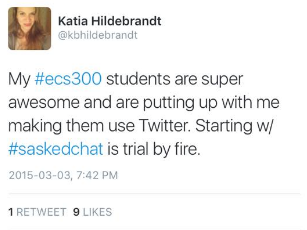This semester in ECMP 455 I chose to tackle the Learning Project for my major assignment. The purpose of the infamous Learning Project is to learn a skill that is significant and complex using online sources (i.e. videos, text resources, podcasts, etc.) and to document and share learning progression openly in an online space. I had the opportunity to do a Learning Project when I took ECMP 355 last year in the spring semester, and I enjoyed the assignment so much that I decided to do it again. For my ECMP 455 Learning Project (or Learning Project 2.0), I learned how to cook. Here’s a quick recap of my Learning Project experience this semester:
Learning Project Recap
Blog Post #1: Learning Project 2.0
- Introduction and rationale for my Learning Project
- Factors to consider: cost and nutrition
- Goals for the end
Blog Post #2: Cost-Effective Cooking
- Recipes:
- Overwhelmed by the number of resources available online
- Attempting new cooking techniques: blackened chicken
- Learning to be cost-effective
- Pictures showing progress
Blog Post #3: Perfecting Pasta
- Recipes:
- Saving money by buying in bulk
- Starting to realize the cost of living on my own — going to need to put money into stocking up on basic, everyday ingredients and spices
- Pictures showing progress
Blog Post #4: Beef, Broccoli, and Bananas
- Recipes:
- Grocery shopping frustrations
- Difficult to find some international ingredients
- Overspending on one meal
- Learning to make use of overripe/old ingredients instead of letting them go to waste
- Pictures showing progress
Blog Post #5: A Healthy Twist on Spaghetti and Meatballs
- Recipe:
- Working with new ingredients
- Critiquing resources: written vs. tutorial videos
- Learning to be more adventurous in the kitchen — cooking becoming less of a chore
- Pictures showing progress
Blog Post #6: The Breakfast Casserole That Took a Hundred Hours
- Recipe:
- Demonstrating my learning in new ways: Tasty-like tutorial video
- Personal frustrations
Blog Post #7: Boomerang and Buttermilk Waffles
- Recipe:
- Trying new appliances: waffle maker
- Demonstrating my learning in new ways: Boomerang videos
Blog Post #8: Crock-Pot Chicken Noodle Soup
- Recipe:
- Trying new appliances: crock-pot
- Saving money by cooking in large quantities
- Boomerang videos showing progress
Reflections on my Learning Project Experience
Going into my Learning Project, I didn’t really have a specific end goal in mind. All I wanted was to simply increase my cooking skills so that, by the end, I could make more than just pasta. Over the course of the semester, I feel as though I have learned a lot. I went from having quite limited cooking skills to mastering a ton of new recipes, working with new ingredients, trying new kitchen appliances, and learning how to cook on a budget — a skill that will be very useful to me once I move out and have to start being conscious of how much money I am spending on things like food.
If I were to do this project again, I would narrow it down, for example, to just learning how to cook different dinners or different lunches, just one type of cuisine, or just crock-pot recipes. One of the challenges that I continuously encountered in my Learning Project was the fact that there are literally thousands of cooking resources available online. This wasn’t necessarily always a good thing — it was overwhelming, and it made choosing what to cook each week very difficult. Even though I feel like I learned a lot from this Learning Project, I think I could have learned more, specific skills had I narrowed my project down. This would be something to consider for next time.
I also recognize that it was a privilege to be able to do a project like this. Even though budgeting was a factor that I considered throughout my Learning Project, I realize that my $25/meal budget was still quite a bit of money, especially when I was doing it week after week. I recognize that a lot of people cannot afford the luxury of buying fresh produce and that canned/boxed food is a reality for many people.
It may have not always been a smooth learning experience, but I can definitely see the benefits of learning a skill online and sharing about progress openly in an online space. Through my Learning Project, I was able to learn from and critically analyze a variety of online resources, I was able to share my learning progress openly through my blog and through Twitter, and I was able to receive feedback and support from my classmates. Overall, I’m glad that I had this experience again. Thanks for following my learn-to-cook journey!
![IMG_2140[1] IMG_2140[1]](https://amypmartin.files.wordpress.com/2017/04/img_21401.jpg?w=202&resize=202%2C202&h=202#038;h=202&crop=1)








![IMG_2140[1].JPG](https://amypmartin.files.wordpress.com/2017/04/img_21401.jpg?w=592&h=444)



















 I also attempted some baking on Family Day. We had some overripe bananas in the house, and since I’m all about saving money in this project, my mom suggested that I try to find a recipe where I could use the bananas so they wouldn’t go to waste. In the end, I actually found and tried three different recipes using the bananas. And, the best part: since I had all of the ingredients at home already, it cost me absolutely nothing to make these three recipes! This kind of made up for the fact that I was almost $20 over-budget with the beef & broccoli recipe.
I also attempted some baking on Family Day. We had some overripe bananas in the house, and since I’m all about saving money in this project, my mom suggested that I try to find a recipe where I could use the bananas so they wouldn’t go to waste. In the end, I actually found and tried three different recipes using the bananas. And, the best part: since I had all of the ingredients at home already, it cost me absolutely nothing to make these three recipes! This kind of made up for the fact that I was almost $20 over-budget with the beef & broccoli recipe.


